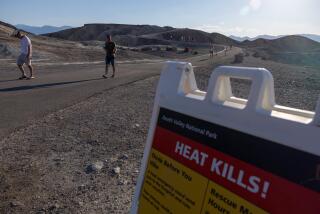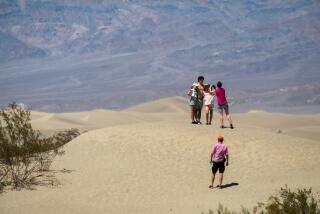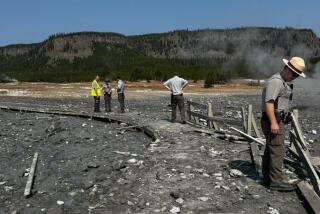Flash floods trap visitors, rangers in Death Valley National Park
Severe thunderstorms over Death Valley National Park knocked down power lines late Sunday, sent mud barreling into a historic building and forced visitors and rangers to hunker down overnight in a volcanic crater.
The flooding left about 20 visitors and three park rangers stranded in Ubehebe Crater, in the north end of the park, so they had to spend the night in the desert, said park spokeswoman Abby Wines. The group maintained contact with the park’s headquarters through the night until they safely exited Monday morning.
Some of the visitors had traveled to the park to view the night sky, but torrential rains interrupted the plans, Wines said. No one was injured in the downpour, which forced the evacuation of campers from Mesquite Campground just after 10 p.m. Sunday.
Park officials thought thunderstorms were possible but never expected a devastating effect on the park, Wines said. The deluge felled four power lines, damaged a road and left about 2 feet of mud and debris inside the visitor’s center at Scotty’s Castle, a Spanish-style mansion that offers guided tours.
The visitor’s center -- which occupies the garage portion of the ranch house named for Walter Scott, known as Death Valley Scotty -- will be closed for several days. No damage has been reported to Scotty’s Castle.
California 190 remains open, but most other park roads are closed on account of heavy rains that have slammed the area over the last two weeks, park Superintendent Mike Reynolds said in a statement.
The following roads are closed: Badwater Road (Highway 178), Scotty’s Castle Road (North Highway), West Side Road, Big Pine-Death Valley Road, and Racetrack Road.
In recent weeks, rain has been plentiful in the park, which is known for its searing heat.
The park has received 1.23 inches of rain this October, exceeding the average rainfall of 0.07 inches for the month, according to the National Weather Service. The annual rainfall average in the park is 2.36 inches, the weather service said.
The storms can be attributed to a low-pressure system from northern Mexico that brought rain more than a week ago, then moved off to the coast before circling back, said Mike Paddock, a meteorologist with the National Weather Service in Las Vegas. The storm had been lingering over the area when a second low-pressure system from the north swooped in. The combination of the two storms resulted in intense rain and thunderstorms.
The storm systems are not related to El Niño, a warm-weather pattern that is expected to bring intense rain to California this winter.
Although the most recent thunderstorm proved damaging, it’s not the worst storm to arrive in the park.
In August 2004, heavy rainfall triggered a devastating flood that killed two people, knocked out power and phone service, overturned cars and forced the park to close for 10 days.
For breaking news in California, follow @VeronicaRochaLA
More to Read
Sign up for Essential California
The most important California stories and recommendations in your inbox every morning.
You may occasionally receive promotional content from the Los Angeles Times.










